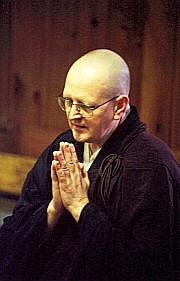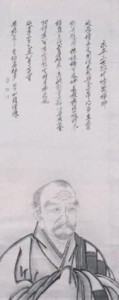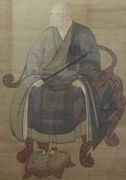Denkoe Dharma Talk
A Talk by Kyogen Carlson on Koun Ejo and the Denkoroku
 Note: Dharma Talks during the Denkoe Sesshin are usually reserved for those attending the retreat. This year the Wednesday talk was open to anyone who wished to attend, and Kyogen included information on Keizan and the context for the creation of the Denkoroku.
Note: Dharma Talks during the Denkoe Sesshin are usually reserved for those attending the retreat. This year the Wednesday talk was open to anyone who wished to attend, and Kyogen included information on Keizan and the context for the creation of the Denkoroku.
On the 11th day of the 1st month, in the year 1300 Keizan gave a talk to the monks of Daijo-ji about Shakyamuni Buddha. This talk became the first chapter of the Denkoroku. He had recently been installed as Abbot of Daijo-ji, succeeding his teacher, Tettsu Gikai. Gikai was elderly and ill, living at the temple with Keizan looking after him. He would die nine years later.
The founding teacher of the newly forming Japanese Soto Zen tradition, Eihei Dogen, had been born just 100 years earlier, in 1200, living only 53 years. Now, 47 years after Dogen’s death, the Soto tradition was in trouble. It was in real danger of fragmenting into several idiosyncratic lineages away from Eihei-ji, and a hide-bound, very conservative monastic core inside Eihei-ji, following a practice more Chinese in flavor than Japanese, and mimicking the founder without his powerful, dynamic presence and teaching.
This is not uncommon after a very strong founder leaves the scene. If those that follow can’t measure up to the dynamic personality that went before, they often simply mimic that person, following the “What would the founder do?” method.
Eihei-ji had a strong leader to start in Dogen, and a good Dharma Teacher in his successor, Koun Ejo, who is the subject of this year’s Denkoe Sesshin. Still, the time of strong leadership was short. Ejo was older the Dogen, and retired in 1267, returned in 1272, died in 1280.
In the Denkoroku chapter on Dogen, Keizan describes the great Founder’s years in China. He had travelled to various teachers and engaged them in dialog, but couldn’t find someone who could match is brilliant intellect. In his chapter on Dogen Keizan says, “Having thus engaged in dialogue with various teachers, Dogen became very conceited and thought there was no one in Japan or China equal to himself. As he was about the head back to Japan, someone told him, ‘The only one in China with the eye of the Way is old Rujing – you will surely benefit by seeing him.’ Even so, it was over a year before he had the opportunity to call on Rujing. At that time Zen master Rujing had just become abbot at a certain public monastery, replacing the recently deceased former abbot. Considering circumstances met, Dogen went to him to resolve his doubts. At the very outset his attack was blunted, and hence he became a disciple of Rujing.” Dogen was brilliant, very well educated, and confident. He found someone who could best him, someone he could learn from. With such a teacher he would eventually “drop off body and mind” and awaken deeply.
The chapter on Ejo describes another very bright and competent man who became learned in several Buddhist traditions, and who had many profound insights. Keizan describes his encounter with Dogen.
“Priest Eihei Dogen returned to Japan and Kennin Monastery in 1227 to refine his practice. There was a rumor that he transmitted the True Dharma from China and privately wanted to spread it. The master got wind of this and thought, “I understand the Tendai teaching of the three cessations and three contemplations and have grasped the essential practices of the one approach of Pure Land Buddhism. Moreover, I studied at Tonomine and grasped the essence of seeing essential nature, becoming a Buddha at once. What could Dogen have brought from China? He visited Dogen in order to find out. During the several days when they first talked, they thought they saw things the same way and discussed the inconceivable knowledge of seeing essential nature. The master was overjoyed, thinking that his understand was the same a Dogen’s and genuine, and he praised Dogen all the more. After several days passed, Priest Dogen revealed an extremely different understanding. At that time the master was surprised and was about to raise an argument, but he realized that there was something beyond his own truth and quite different. Therefore, … he again aroused a determination to rely on Dogen and hear his teachings.”
Ejo went on to a profound awakening of the fundamental point of our tradition, and would later awaken many others. More on that at the end of this talk.
With this strong foundation, why was the Soto tradition in trouble less than 20 years after Ejo’s death? Several factors are involved. One is Dogen’s early death, after establishing a very strong and strict monastic practice. Had he lived longer he could have added some breadth to the depth of the practice he advocated. That was certainly true of Shakyamuni himself, who lived long enough to have taught a great variety of styles. Another factor is that Dogen brought a Chinese style monasticism to Japan, and he didn’t live long enough to bring in more Japanese elements. A third factor is that Dogen converted monks from other traditions to his style. In fact nearly all of them had extensive training in Tendai and Shingon Buddhism, and many of his key disciples were ordained and some transmitted in the Daruma-shu tradition, a controversial and unorthodox lineage.
After Dogen’s death, Ejo became Abbot at Eihei-ji. Immediately questions of “orthodoxy” vs. “heterodoxy” arose, not unlike what happened 100 years after the Buddha’s death at the second council. The argument there was whether or not any of the minor vinaya rules could be changed. That dispute led to the split that developed into the Mahayana and Theravada division. At Eihei-ji, it led to the controversy that would become known as “Sandai Soron,” or the third generation controversy.
Ejo himself had been a Tendai monk, practiced and studied Shingon (esoteric tantric) and Jodo-shu (pure land), and had been with the Daruma-shu monks when he decided to join Dogen. Later, many others from that tradition would join Dogen’s community. He was accomplished and led others to awakening, but he was not the great founder himself. He held the community together, but the tension between adaptation and innovation on one side and strict orthodoxy on the other was already strong.
Tettsu Gikai was headstrong, and not always known for diplomacy. He was also a Daruma-shu monk, and in fact received transmission in that lineage from his old teacher, who was also studying at Eihei-ji. This transmission happened well into Gikai’s years at Eihei-ji. Nonetheless, Dogen saw great potential in him, and eventually Ejo also gave him transmission in Dogen’s lineage, then made him successor at Eihei-ji. Gikai was an innovator and wanted to bring ritual elements from Shingon and Tendai into the practice at Eihei-ji. In fact, this would have been advisable in order to maintain a strong connection to their donors, but he was ousted by the conservative faction. There followed some back and forth, with both Ejo and Gikai returning as Abbot for periods of time. Gikai returned, was ousted again, so Ejo returned from retirement. Just who really was the legitimate “third abbot” is the sandai soron, or third generation controversy. Eventually the abbotship went to the monk Giun, a disciple of Jakuen, a Chinese monk who followed Dogen to Japan from China to practice with him. Eihei-ji remained in this very conservative line until 1468, almost 200 years.
So, let’s go back to the year 1300. Gikai is ill and will die soon. Eihei-ji has declined, having lost vitality and donor support. Most of the other descendants have mixed lineages and could well blend back into the dominant traditions. Keizen starts the Denkoroku.
The Denkoroku is unique in Zen literature. Most other “lamp records” are collections of koans, stories from many different lineages, formed for studying various types of encounters and teaching styles. This one follows one lineage exclusively, and it focuses on the transmission of the essential matter rather than a variety of things. The closest things to it are two Chinese texts, the Chuan Deng Lu and Wu Deng Hui Yuan. These follow one line from Shakyamuni through Hui Neng, and indeed this is where Keizan got the material for the Indian and much of the Chinese line. His style is different, however, expanding the stories to be more warm and human, and putting central emphasis on the fundamental awakening. The Chinese texts, however, branch out after Hui Neng to cover the many lineages developing in China. Why did Keizen stick with just our line?
Keizen recognized the profundity of Dogen’s teaching, and especially the fundamental point in the master-disciple transmission. This text makes that abundantly clear. Keizan was about to renounce the Daruma-shu lineage he had also inherited to focus on this one. In the Denkoroku, as in his own life and teaching, he shifts the primary emphasis away from monastic forms to the matter of awakening itself, which is right where it should be.
Later, after his old teacher Gikai died, Keizan founded another monastery, Yokoji. Keizan passed Daijoji on to his successor Meiho Sotetsu, and spent most of the rest of his life at Yokoji. It was at here that an important event took place. Until this time, Keizan and others still held transmission documents from Dogen and the Daruma-shu. By this time Keizan was the most eminent of these monks, indeed, the most eminent of Dogen’s descendants, and he decided to focus only on the lineage tradition through Dogen and Nyojo. In 1323, at the age of 56, Keizan had a remarkable monument built on the hillside behind the main temple buildings at Yokoji. Called the Goroho (Five elders mound), it is, basically, an earthen Stupa, or reliquary, for the five founding teachers of the lineage through Keizan. The Goroho is a natural looking hillside with trees, shrubbery, grasses and stones, but it also stores discourse notes by Tendo Nyojo, some of Dogen’s ashes, Koun Ejo’s blood-copied sutra, Tettsu Gikai’s Shisho (primary transmission document), and later, Keizan’s Shisho was added. Some modern scholars say that, in many ways, the Japanese Soto School took form at this time. Although Keizan continued the adaptations started by his teacher, Gikai, it brought an end to the controversy concerning the Daruma-shu influence, and led to the integration of the lineages in later years. Keizan’s grave is also at Yokoji, and along with the Goroho, this makes the temple an important place in Soto Zen.
Keizan would spread Dogen’s teaching far and wide because he was able to adapt Soto practices to the Japanese landscape. Soto became increasingly successful, and Eihei-ji also recovered. Keizan had studied with Rinzai teachers after his transmission with Gikai, a practice Gyokuko and I both followed by studying with Shodo Harada after transmission with Jiyu-Kennett. Keizan’s influence made Soto Zen warmer and more human in general, appealing to the general public, while retaining a strict monastic core. Soto Zen eventually would become the largest Buddhist sect in Japan.
So, back to the Denkoroku and this retreat: What did Ejo realize when he was studying with Dogen? Ejo had been studying a koan, “Shishuang’s a single hair pierces many holes,” one of the 300 koans Dogen used with his students.
Shishuang Chuyuan was once asked by Senior Monastic Quanming, “When does a single hair pierce innumerable holes?”
Shishuang said, “Ten thousand years later.” Quanming said, “What will happen ten thousand years later?”
Shishuang said, “It is you who will pass the examination and excel among people.” Later Quanming asked the same question of Zen master Hongyin of Jingshan [Faji]. Jingshan said, “You personally will have to shine your sandals and harvest the fruit.”
COMMENTARY A single hair piercing innumerable holes is a formidable task requiring diligent effort and relentless perfection. Raising the bodhi mind, practice, and realization—whether in sacred or secular realms—require the same single-minded dedication. Quanming’s question is: when is the goal reached? Shishuang says, “Ten thousand years later.” What is his meaning? [My answer: Non-arriving, endless practice – this is “many holes.”] If you wish to appreciate Shishuang’s teaching, you must first realize that the process and the goal are a single reality, and then you must understand that to attain one dharma is to penetrate one dharma, and to encounter one activity is to practice one activity. This is called one-practice samādhi [Ejo had studied this. It is a principle the the Mohe Zhiguan]. In it there is no past, present, or future. There is just this single moment that transcends all space and time [This is the single hair]. Ultimately, this is not the doing of self or other but, rather, the myriad dharmas advancing and realizing the self. But say, what does Jingshan mean when he says, “You personally will have to shine your sandals and harvest the fruit?” I ask, what are you calling your self?*
The clue is fairly simple. It’s about the one and the many, the single hair the many holes. It’s about the minute and transcendent all at once. “So minute, it enters where there is no gap, so vast it transcends all dimension.”
Ejo had studied material that the koan refers to, but this was expressed in a way he had not heard before. The key is deep zazen: stillness, original mind, and bright awareness penetrating to the core. It is one thing to grasp the meaning. It is another to experience it with the whole body and mind.
This difference is what Keizan is pointing to with the Denkoroku. It is, ultimately, what really matters.
We are in a period of transition. Not just to a new property, but new teachers are stepping forward. Keizan’s writing the Denkoku and establishing the Goroho speak to me deeply right now. As we go forward, as grow and the branches of this Dharma Cloud family spread, let us keep this essential matter clearly and firmly in mind.
* Translation by Kazuaki Tanahashi and Daido Loori. This commentary is adapted by Daido for this translation.



